If it seems like we’ve been covering Q a lot this year, you’re right. The new company is hitting it hard, releasing suppressors and firearms to the market at a brisk pace. Two of their newest are the Half Nelson and Full Nelson, both of which Silencer Shop was kind enough to let me borrow. I threw these lightweight, .30 cal cans up against my Dead Air Sandman Ti to see how they stack up to an industry leader.
https://www.youtube.com/watch?v=41kyz2BfaBQ
This is probably as good a time as any to mention that Q’s marketing has been hilarious and engaging. I know I’m among many who follow them with interest on Instagram. They continue to surprise with a good sense of humor, direct shots at competitors, a little light trolling, and comical if not slightly ridiculous product packaging and product names (e.g. the Trash Panda and Thunder Chicken, the QD attach versions of the Nelson Bros.).
So when you receive a Q can, expect a bit of silliness in its unboxing. In the case of the Nelson Bros., the box’s outer sleeve is printed with a WWF-style wrestling theme, complete with Kevin Brittingham’s dad, Ken, depicted in pre-fight robe. Slide off the sleeve, and Ken has lost his robe revealing more…well, it’s more revealing.
Inside the box is the suppressor itself, which in-turn is inside of a very nice pouch made by Blue Force Gear. Though, if a silk baggie is more your speed, there’s a luchador baggie that goes with any outfit. A Q wrestling belt decal rounds out the themed swag. I almost missed the wrestling ring ropes printed inside of the bottom half of the box; it’s the details that count.
Anyway, Q’s products may have silly names but they themselves are quite serious. Representing arguably the most modern design in the rifle suppressor world short of 3D printing, the Full Nelson (top) and Half Nelson (bottom) are “tubeless” cans. In effect, the baffles are welded to each other and the outside of those baffles more or less creates the suppressor body, or “tube,” instead of welding baffles together and then welding a separate tube over the top of them. This reduces weight while maximizing internal volume.
And, in the suppressor world, more volume equals less volume. That is, more space inside the suppressor in which to slow down, cool, and expand the gases ejecting out the muzzle of the firearm equals more sound reduction. Clearly the Full Nelson, at 8.86″ long, is after maximum internal space while the Half Nelson, at a short-for-.30-cal 6.85″ long, is balancing noise reduction with a bigger nod to weight and length considerations.
Another factor often overlooked is diameter. Since the volume of a cylinder is the square of its radius multiplied by its length, even a small change in the girth of a suppressor makes a big difference in its internal volume. Q has designed the Nelson Bros. with a 1.75″ diameter instead of the market norm’s 1.5″. End result? 36% more space inside.
Of course, with norms being norms there are a lot of products made to suit those norms. For instance, the Lancer Systems handguard on my 8.3″ 300 BLK SBR. The 1.5″ diameter Sandman fits under it nicely. So did the GEMTECH Tracker and the Yankee Hill Machine NITRO 30.
The Nelson Bros.? Not so much.
Which is a shame, because — spoiler alert — I sort of fell in love with the Half Nelson for 300 Blackout use. Shooting all three of these suppressors on the 300 BLK IWI Tavor X95, the sound level difference was so minimal at the shooter’s ear that the short length and extremely light weight of the smaller Nelson really stood out. It looks awesome and it feels awesome.
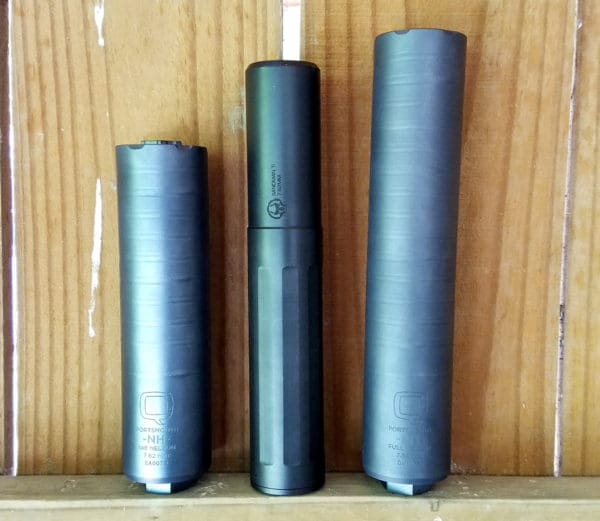
At 12.2 ounces, the 6.85″ long Half Nelson is one of the lightest .30 caliber suppressors on the market. Despite this, it’s still rated for .300 Winchester Magnum and it has no specific restrictions on rate of fire. Placed in the middle in the photo above, my Sandman Ti is 8.2″ long and weighs 16.8 ounces. On the far right, Q’s 8.86″ long Full Nelson tips the scales at 16.6 ounces. That’s right, the wider, longer can still weighs less than my fairly lightweight Sandman Ti.
Ultimately, my Sandman with its Stellite (a very high grade of stainless steel) baffle core and titanium tube would hold up to more abuse and more sustained, full-auto fire than the Nelsons with their 100% titanium builds. This is important to me because…well…okay it’s nice to know something is extra durable but, back in the real world, I won’t be pushing the temperature handling limits of any of these full-auto-rated silencers.
Slightly blue-gray-light-purple-ish in color, Q’s suppressors are PVD treated rather than Cerakoted or the like. This is, without a doubt, a more durable and resilient finish. Though I know some consumers will balk at the pearly purple hue.
At the Nelsons‘ mount side is a simple hex head, useful in the removal of a stuck can.
However, it isn’t really necessary as the gear-like muzzle shape will also accept a box wrench or a 12-point socket and provide the same utility. Because of this, I think I’d actually prefer if the base of the suppressor were simply flat with no protrusions like it is on my Sandman.
A look inside the mount end of either Nelson shows a section of taper-mount followed by standard, 5/8-24 threads. If you have a matching taper-mount barrel, this is truly ideal as less torque is required to ensure a solid, leak-free seal between barrel and suppressor. It’s also less likely to loosen while shooting and it better-aligns the can to the bore.
If you have standard barrel threads with a square shoulder, though, you’re going to “waste” some of those threads on empty air — they’ll slide right through the taper-mount section. On the one hand, this allows the Nelsons to thread on and off faster since fewer threads have to be engaged before the suppressor is tight up against the barrel shoulder. On the other hand, fewer threads are engaged.
Of course, this appears to have been taken into account and, with typical 5/8-24 muzzle thread specs, you’ll still have a sufficient amount of engagement into the Half or Full Nelson’s threads to ensure it’s secure. I didn’t encounter any issues here, even on the Tavor with its mandatory lock nut eating up thread depth.
Out on the range I repeatedly swapped between all three of these suppressors while shooting both supersonic and subsonic 300 BLK through the Tavor and .308 through a 16″ bolt gun.
Again, on the 300 the perceived volume level at the shooter’s ear was so darn similar that the choice is easy: I’d get the Half Nelson. It looks and feels the best and it provides all the suppression necessary to make shooting a hearing-safe and comfortable experience. It also sounded to me like the Q cans had a slightly deeper tone to them than my Sandman, which is, itself, regularly lauded for having a pleasant tone.
Based on Silencer Shop’s dB testing, as measured one meter off the side of the muzzle, approximate dB reduction performance on a 9″ 300 Blackout with subsonic ammo is as follows:
• Q Half Nelson: 34.1 dB reduction from measured baseline
• Q Full Nelson: 39.6 dB reduction from measured baseline
• Dead Air Sandman Ti: 37 dB reduction from measured baseline
Basically, the average here is somewhere around 124 dB. Way below the 140 dB hearing-safe threshold for impulse noises and way, way below the ~161 dB that a 9″ 300 BLK puts out unsuppressed.
Over to the 16″ .308 and, with that short barrel, the cans have plenty of work to do. On this setup, even suppressed, I wouldn’t normally shoot much without hearing protection, though at the shooter’s ear all three of these suppressors should be OSHA hearing safe. Although the Half Nelson may be cutting it close.
Between the Full Nelson and the Sandman it was more or less a wash. As mentioned in the video, with the ear pro off I believe I could subjectively tell that the Full Nelson was barely quieter. However, it’s also possible that its slightly deeper, more solid tone simply seemed quieter to my ears. Either way, they’re both about as quiet as a .30 caliber suppressor gets.
From behind the gun the difference in length and weight between the two is also a wash. If I were deciding between them, I suppose it would come down to mount style, aesthetics, and cost.
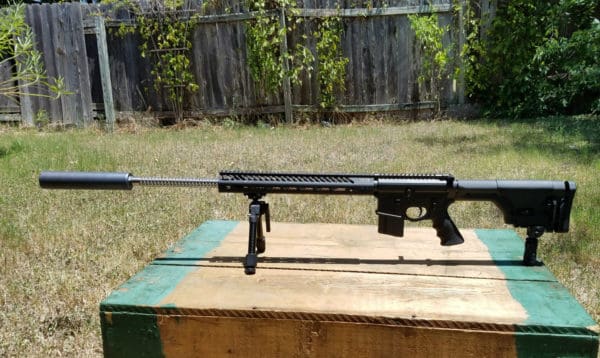

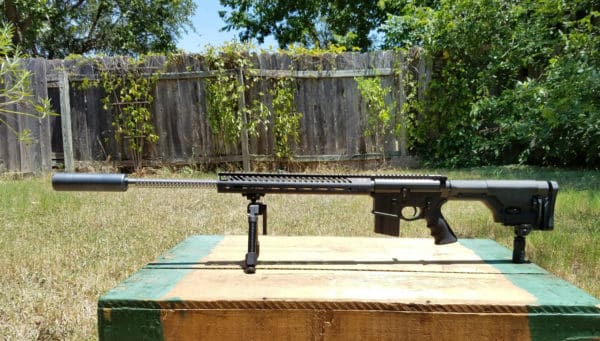
With the Half Nelson, you’re no longer looking at industry-leading dB reduction. Rather, you’ve traded some of that off for light weight and short size. Which, of course, has its place. For instance, on a hunting rifle that you’re lugging miles into the wilderness or on a PRS rifle being shot from weird position to weirder position in a hurry.
The Half Nelson was obviously louder than the other two cans. If I were shooting .308, .300 Win Mag, 6.5 Creedmoor, etc. in a mostly recreational fashion, I’d choose a larger, quieter suppressor. For most hunting, competition, or sniper duty, or if it were primarily a 300 Blackout (and 5.56) suppressor that sometimes saw use on more powerful cartridges, I’d lean heavily towards the Half Nelson instead.
Approximate dB performance figures on .308, as measured a meter off the side of the muzzle (numbers measured at the shooter’s ear, on a bolt-action rifle, would be expected to be 6 to 7 dB quieter) are:
• Q Half Nelson: 143.5 dB average (24.6 dB reduction)
• Q Full Nelson: 136.6 dB average (31.5 dB reduction)
• Dead Air Sandman Ti: 138.1 dB average (30 dB reduction)
Half Nelson:
Half Nelson:
If we’re honest, the Half Nelson is actually more of a 3/4 Nelson. Though I’m told girth is more important. And the Nelson Bros. are nothing if not girthy. And extremely well-made with great fit and finish. They sound great, too.
Perhaps the hardest part is deciding between full size and 77% size. Throw in Q’s QD mount versions, the Trash Panda and the Thunder Chicken, and now it’s a real toughie.
Off the record? I’m planning on picking up a Trash Panda this fall. I’ve been extremely happy with my .30 caliber suppressor, the Dead Air Sandman Ti, but I chose it in a pre-Q world. I gotta admit, I find the Nelson Bros. highly compelling.
Specifications: Q Half Nelson
Length: 6.86″
Diameter: 1.75″
Weight: 12.2 oz
Approx dB Reduction 300 BLK: 34.1 dB
Approx dB Reduction .308 Win: 24.6 dB
MSRP: $868 (about $800 via Silencer Shop)
Specifications: Q Full Nelson
Length: 8.86″
Diameter: 1.75″
Weight: 16.6 oz
Approx dB Reduction 300 BLK: 39.6 dB
Approx dB Reduction .308 Win: 31.5 dB
MSRP: $899 (about $845 via Silencer Shop)
Ratings (out of five stars):
Overall * * * *
While there are suppressors with more features — interchangeable mounts and end caps, for example — and suppressors rated for more abuse, I think Q’s new line of .30 cal cans are my favorite .30 cal cans on the market. Flawless quality combined with extremely light weight and excellent sound suppression, plus a taper mount that also works on square shoulders (and the option of QD attach models) brings together a lot of awesomeness under one roof. If I were to change anything, it would be getting rid of the external mount area and effectively pushing that into the suppressor to create a flat bottom; I simply think it would look better that way.

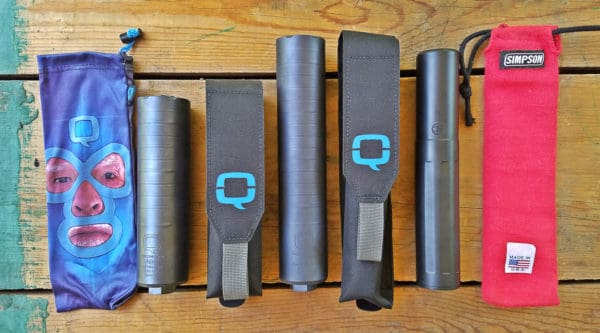
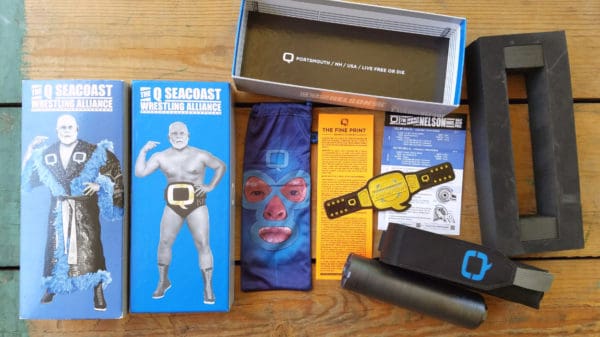
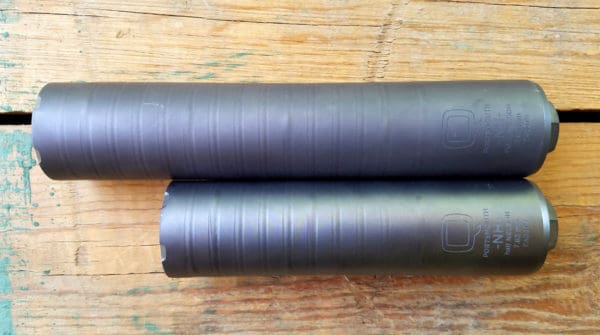
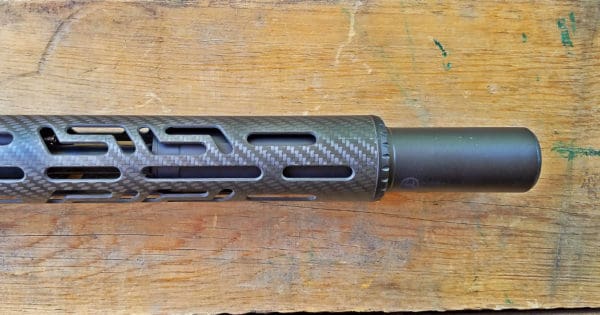


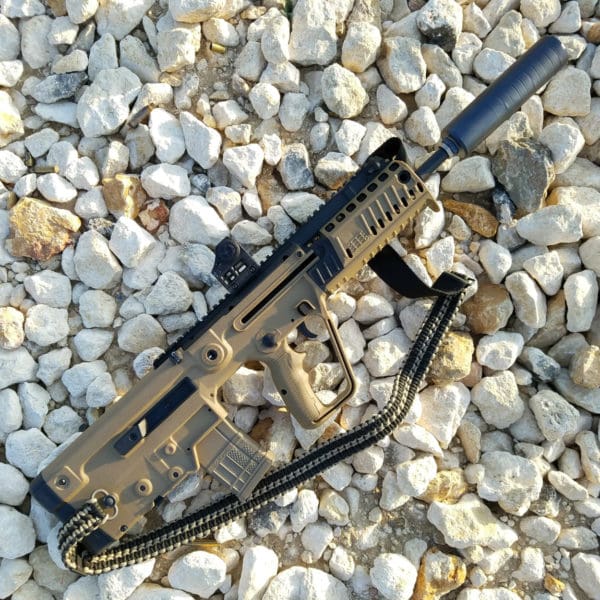
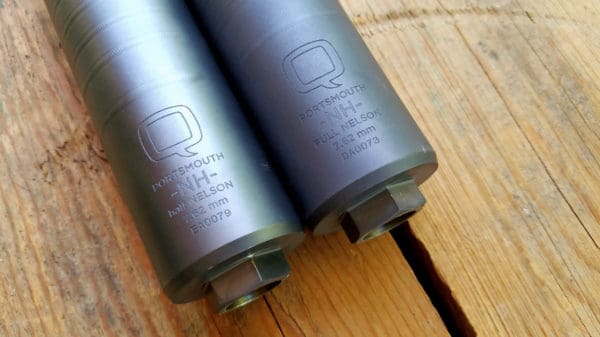
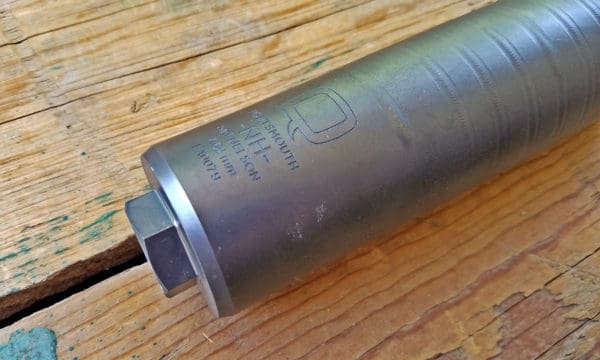
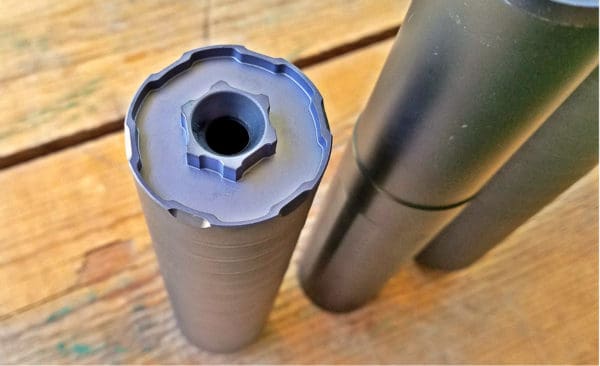
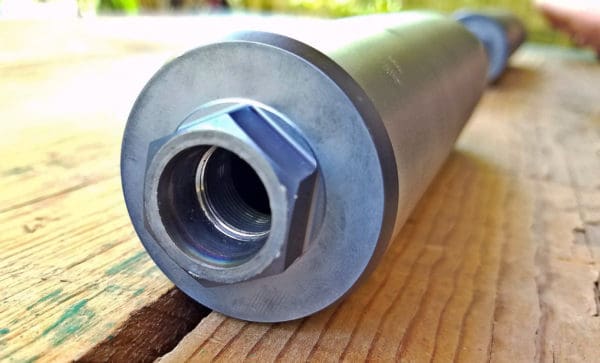
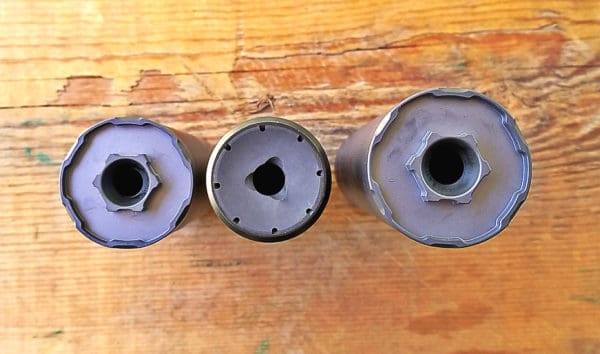
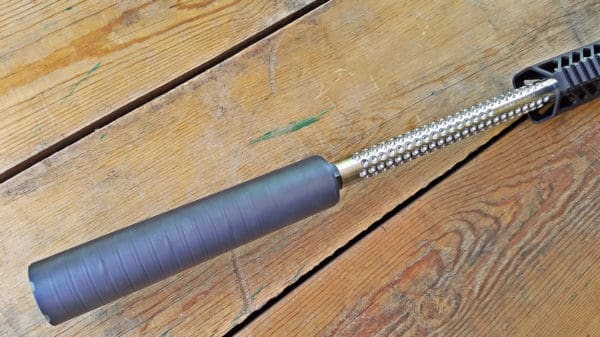
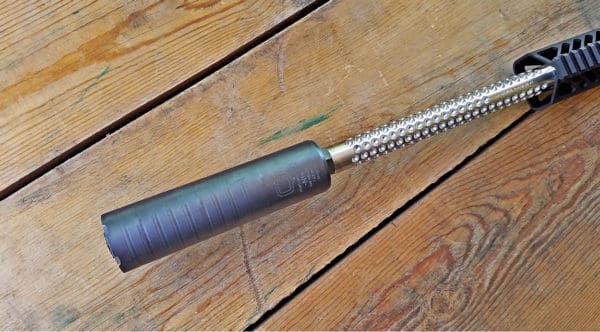
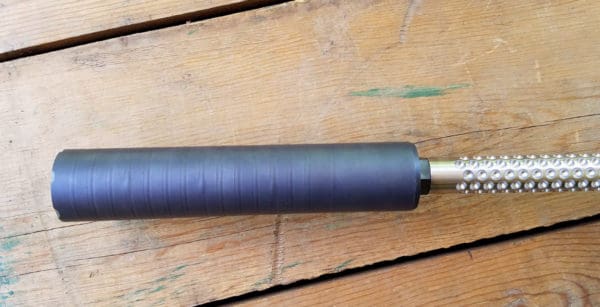
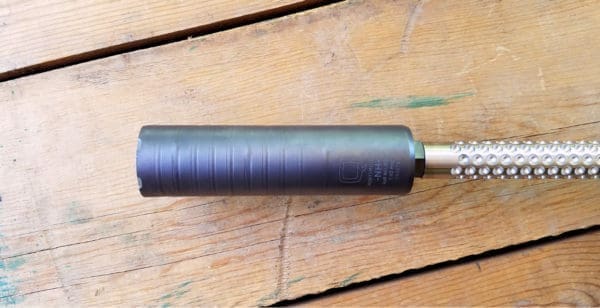



Are the Trash Panda and Thunder Chicken (hilariously fun names, IMO) suppressors just quick-attach versions of the direct-thread Half Nelson and Full Nelson suppressors?
Yes. As far as I can tell they’re effectively identical otherwise. Those cans ship with two of Q’s “Cherry Bomb” QD compensators; one threaded 1/2-28 and one 5/8-24. Pic of the boxes
The reason I specifically chose a direct-thread can for my first .30 cal can was for the ability to easily move it from rifle-to-rifle without having to install a brake on each one first. Basically, for loaner guns coming in for review then going back out. Plus, historically a direct-thread can is a bit better for accuracy. For just my own personal collection of rifles, I probably would have gone QD instead and just “permanently” installed an appropriate QD muzzle device on each one. I’m going to get a Trash Panda now mostly to use on my personal rifles, on which I’ll leave a Cherry Bomb installed, but also because the Cherry Bomb does not have to be timed at all — just crank it down without consideration for a specific part of it having to be the top, etc. So I’ll likely also keep two extra Cherry Bombs on hand that I can quickly slap onto loaner guns also (and, btw, they install really easily with a 1/2″ socket!). Or, I’ll use the Sandman Ti for those guns. Well, and also for my 300 BLK SBR since the Q cans don’t fit under the handguard.
Also, as for accuracy, Q’s QD design is particularly simple. There’s no locking mechanism that requires you to have access to the bottom of the suppressor so you can push a release button, and there are no cams or notches or whatever, which require at least a little bit of tolerance in order to work properly and are the reason for lower accuracy as compared to a direct-thread setup. Basically, the Cherry Bomb adds a taper mount and a very short section of somewhat coarser threads, so the can just screws on like a direct-thread one would except it only has to do like one single rotation to go from off to fully tight. So it’s quick like a QD but precise like a direct-thread. Easy peasy.
…it also acts as a blast baffle, so ultimately I’d expect their QD cans to outlast the direct-thread ones.
Just waiting for their next suppressor model to come out, “The Choad”
You know, I’m becoming something of an expert on silencer attachment points, and the 3/4″ hex nut, whether it is on a QD mount or on the can itself, presents problems with barrels that are larger than 0.750″ in diameter at the thread shoulder. If you leave that barrel edge unprotected, sooner or later, it’s going to be damaged. The perpendicularity of that shoulder is essential to alignment of the silencer to be co-axial with the barrel.
Whatever threads onto a barrel must be able to protect that shoulder. A silencer with no nut does that, a larger nut than 0.750″ would do that. I’ve had to make up a washer that was surface ground to a specific thickness in order to protect a barrel thread shoulder on a barrel that was about 0.850″. Silencer manufactures need to start addressing the “thick barrel issue.”
Buy real online usa http://designermenu.co.uk/wp-content/pharmacy/flutivate.html how can you buy real online in usa.
how do you get without a doctor http://www.cuongvu.com/wp-includes/theme-compat/pharmacy/cital.html Over the counter australia.
best online prices for http://www.fireflyrestaurant.com/graphics/pharmacy/trizole.html price no insurance.
психология
Comments are closed.